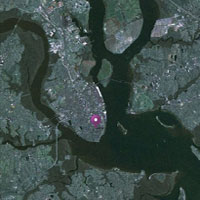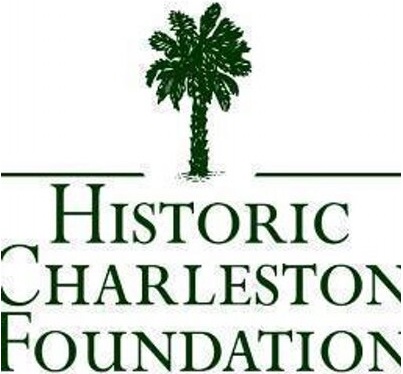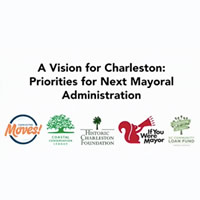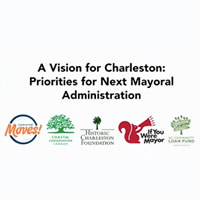


A lot can happen in a city during the course of a week. At IfYouWereMayor.com we’ve been taking a bit of inventory at this psychological milestone of Passover and Easter in the “holy city.” Waking up from the region’s relative slumber of winter is a heady, dusty, and sneezy time. The seasonal changes bring farmers’ markets, baseball, and a groundswell of tourists for the area’s home and garden tours and the beach.
But, the typical shift from winter’s timid grip in Charleston has been rocked by the events of the past few days. The shock of an eyewitness video capturing the shooting of an unarmed African American by a North Charleston police officer has thrust the region into the national spotlight. The world is watching to see if the tension brought to the region will result in violence or widespread protest, just as has been seen in other cities in recent months following incidents involving law enforcement in pre-dominantly African American communities and neighborhoods.
Decisive action by North Charleston’s leadership appears to have defused the situation for now, but the coming weeks will underscore the need for our community to heal, to reach an understanding, and to appreciate all the contributions made by often neglected populations.
The diversity of the Charleston region is one aspect of its livability that fosters the exchange of ideas and cultivates a climate of innovation. This vibrant spirit can lead to economic opportunities that reach every segment of the region’s population. But the invigorating climate of diversity only works when everyone feels that their contributions can count. Maria Popova’s blog Brain Pickings provides these thoughtful remarks on hope v. cynicism, and it seems particularly apropos for the Charleston region this spring.
“Finding fault and feeling hopeless about improving the situation produces resignation — cynicism is both resignation’s symptom and a futile self-protection mechanism against it. Blindly believing that everything will work out just fine also produces resignation, for we have no motive to apply ourselves toward making things better. But in order to survive — both as individuals and as a civilization — and especially in order to thrive, we need the right balance of critical thinking and hope.”

Henry Grabar writes, in his most recent Science of Cities column for the online magazine Next Cities (here), that some researchers are trying to reduce a city’s image to data points. Their thinking is to develop a metric that captures a city’s image precisely, so the “brand” can be used to attract various audiences – residents, entrepreneurs, businesses, and tourists. But, is this just an effort to over-simplify the complexity that is part and parcel of a city? At IfYouWereMayor.com we ask whether a city’s true self is completely captured by an image on a postcard, or is there is more to the city than meets the eye?
From 30,000 feet, the Charleston region is very much characterized by the water and a healthy dose of green forests and marshlands, especially at its boundaries. Early European settlement on the peninsula was focused in the southeast quadrant – it was high ground and provided for a port protected by the natural configuration of the harbor and barrier islands. This spot also apparently attracted the earlier native people, the Kiawah (Gene Waddell’s Indians of the South Carolina Lowcountry, 1562-1751).
Rather than guiding more recent settlement patterns of the region or signifying the Charleston “brand,” these inherent geographic features have often been paved over, filled in, or otherwise compromised, all too often to facilitate the convenience of large real estate development or the route of a powerline. This is not just a recent phenomenon, but includes the filling of many of the peninsula’s natural tidal creeks and construction of the High Battery. For those with an interest in the particulars, the Preservation Society of Charleston has an incredibly interesting interactive resource on the shaping of the peninsula as it now exists, using the 1948 map by Charlestonian Alfred O. Halsey (here).
The water, marsh, and various types of lowcountry forests, while diminished, are still hallmarks of the region. What shape would the region’s future development take if it were to use these geographic elements as points of departure? Would we reveal some of those in-filled creeks that perfectly align with many of the city’s areas subject to flooding during rain “events” (and even extreme high tides)? Would public access to the waterways more readily allow for kayaks, canoes, small sailboats, or ferries? Would we cultivate our urban and suburban forests to create more shade on our streets and homes? Would some buildings really have to float or stand over areas that allow tidal flow like the buildings in Venice?
Embracing the geographic realities in the future development of the Lowcountry could make the region more resilient in the face of large storms or rising sea levels, and might capture the imagination of the region as a whole. The Coastal Conservation League has posted a Project proposal related to resiliency and climate adaptation here. Make sure you follow the link to the resiliency plan for Brooklyn. The way they plan to reshape the waterfront edges as green park zones to absorb more tidal flow may be a sign of things coastal cities will have to consider.
We may need to adjust our preconceptions, or our “brand,” to embrace all the aspects that make the entire region special, not just the beautiful historic buildings that are an attraction to visitors and newcomers alike. And, we might find that we must capitalize on the longer traditions of the Lowcountry.

Continuing in our ongoing set of interviews with leaders of Charleston’s constellation of civic-minded organizations, this week’s blog features Charleston native Winslow Hastie, Chief Preservation Officer of Historic Charleston Foundation (HCF).
Some people may think of Historic Charleston Foundation as it relates to historic preservation and the Charleston peninsula, but it seems HCF has gotten involved with some of the larger issues of the region, such as transportation. Can you touch on how your organization’s focus or mission relates to the question of livability for the larger Charleston region? The field of historic preservation has become much more interdisciplinary and multi-faceted over the last couple of decades. The focus has shifted away from merely saving individual buildings (though we still work on that!) towards larger, more complex issues related to livability, urban design, smart growth, and sustainability. The vibrant historic environment of Charleston does not operate in a vacuum, obviously. So many disparate elements affect its long-term health, and HCF has risen to the occasion to address the evolving needs of the community.
It is also important to emphasize that our mission explicitly states that the organization is tasked with preserving and protecting the cultural character of Charleston and its Lowcountry environs. We are not just peninsula-focused. Our reach extends throughout the Lowcountry. More recently, we have been engaged in work focused on the urban-rural edges of our region where tensions have arisen over the appropriateness of development extending further into our rural hinterlands. This includes areas such as Cainhoy, the historic Ashley River corridor, and John’s Island. The need for advocacy in these areas comes from the incredible growth that our region has seen in the last couple of decades.
In terms of our focus on transportation and mobility, that grew out of a strategic planning process that Historic Charleston went through in 2013. We basically looked at every major livability/planning issue in the region, and quickly determined that transportation was the lowest common denominator linking them all. So: let’s focus on that! We recognize that we are not going to “solve” this problem, but we did feel that HCF was in a unique position to frame the issue and bring a diverse set of stakeholders to the table.
Transportation is a huge, complex problem that is going to require the vision and resources of many different groups in the private, non-profit, and public sectors. It is, of course, a regional issue, but we are hoping to help the peninsula lead the discussion and hopefully inspire our neighbors in the tri-county area to help the entire community come up with a sustainable path for the future. The good thing is that no one debates whether or not transportation is a regional priority! Progressive change has to happen one way or another — we’re just hoping that it happens sooner and is done in a fairly coordinated way.
Question 2: Since it is how we frame our conversation, and to put you on the spot, is there something specific that you would do “…if You were Mayor?” Our current focus on setting priorities for a new administration is fairly simple. Over the last few years Charleston has been forced to really analyze many of the issues that relate to explosive growth and our increasing appeal as a major international tourist destination. In this amazing city of engaged citizens, we have no shortage of vision; and we love to express our perspectives and hopes for the future at public hearings, workshops, and visioning sessions. On occasion our collective vision has been collated and distilled into a variety of plans focusing on particular issues or geographic areas of the city.
We already have the:
More recently, Historic Charleston Foundation has been working with the city of Charleston and other community partners on several plans that we think should shape the priorities for a new mayoral administration. These plans include the Peninsula Mobility Report prepared in November of 2014 by transportation expert Gabe Klein. This report states simply: “Charleston must decrease driving and parking while increasing use of public transit, cycling, and walking.” This sounds easy, but turning this statement into reality will require a very significant outlay of public investment in infrastructure for transit and complete streets.
Recently proposed updates to the Tourism Management Plan resulted from a large community effort involving a very engaged Committee and many public meetings over the past year. As tourism has grown substantially over the last decade, it clearly was time for a comprehensive assessment of all aspects of tourism and how it impacts the livability of the city. Great ideas are included in this report, such as creating remote parking and a new Visitor’s Center on the upper Peninsula, but just talking about it won’t suffice.
Also, in the coming months, there will be a report by well-known architect and urban planner Andres Duany concerning the design review process and the Board of Architectural Review. As we are seeing such a huge influx of new development in Charleston, the design and quality of these buildings is of the utmost importance. Historic Charleston Foundation is co-sponsoring this plan with the City, and the report will be completed by this summer.
As is typical with any plan, they are only as valuable as our commitment to bringing them to fruition. Their implementation will require a combination of non-profit advocacy, private sector engagement, and the political will of our leaders. Plans that merely sit on the shelf reflect a lack of ambition and true vision in a community, and at this point in Charleston’s history, we cannot afford that.
It will be very tempting for any future mayoral administration to flex its muscle and try to put its fingerprints on new plans and new priorities — however, it is critical for the new Mayor to understand the importance of all the plans that already exist. We have a strong tradition of proactive engagement and community foresight, so we all need to step up to the plate to turn our progressive vision represented in these many great plans into a reality. That’s what I would do if I were Mayor!

